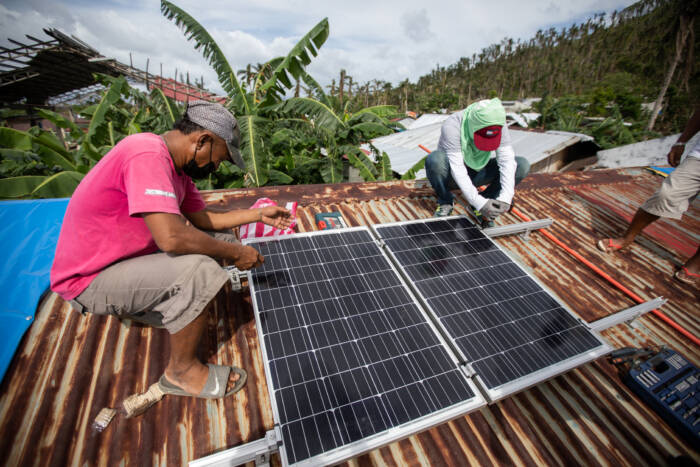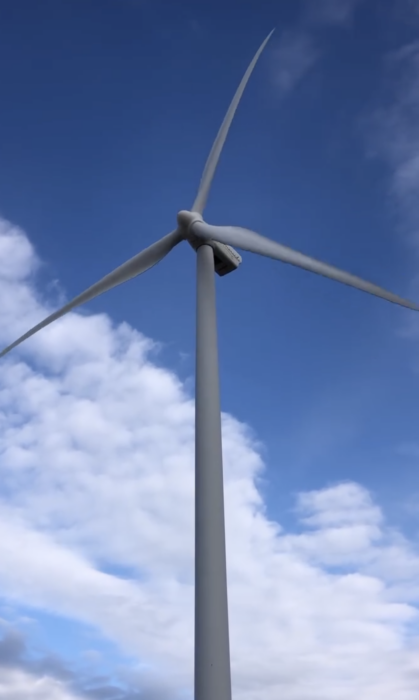
Renewable energy is drawn from natural sources like the sun, and wind, which are either unlimited or replenish themselves constantly. In contrast, fossil fuels like coal, oil and gas are non-renewable resources, taking millions of years to form. Not only are they costly, fossil fuels also heat the planet, destroy the environment and harm communities. But renewable energy is affordable and produces little or no pollution. When done right, renewable energy can help create a prosperous future for people worldwide.
Using sources of renewable energy isn’t just a technical fix to the climate crisis, it is now the smartest way to power our homes, cities, and communities.
Renewable energy comes in many forms, so let’s break down the five main types of renewable energy sources:
1. Solar Energy
The fastest-growing energy source in the world is solar energy, that turns the sun’s light into electricity and heat using panels. Since 2010, the price of solar panels has plummeted by 93%, making it the cheapest source of new electricity in much of the world. As panels can be easily installed on rooftop systems or through solar farms, solar energy is versatile, non-polluting and abundant. Solar rooftop systems installations, managed by local communities, have been transforming lives – from people getting electricity for the first time villages in Ghana and Uganda to keeping power on during climate disasters for communities in Puerto Rico and The Philippines.
Amongst the several benefits solar offers, the industry is also creating jobs at a rapid rate. Globally, it employed over 4.9 million people in 2022, 40% of which were women. At the moment, China is dominating the solar energy sector, installing mega solar projects and making nearly 78% of the world’s solar panels. In fact, excess panels from China are making their way onto rooftops of homes to formerly fossil-dependent countries like Pakistan providing millions with affordable electricity.
But we still need to be careful about building big solar farms, making sure they respect local communities, win their consent, and preserve land and wildlife to minimize any harm.

Communities in Philippines install solar panels to gain power access to during blackouts caused by hurricanes.
2. Wind Energy
Another very clean energy source that is seeing rapid growth is wind energy. Wind power uses turbines to turn moving air into electricity, creating no pollution while running. Wind farms can be built on land (on-shore) or out at sea (off-shore). As it’s cheap and easily available, a lot of countries are turning towards wind power to meet all or most of their energy needs. In Uruguay, wind energy already powers 90% of the country while Denmark gets over half their power from wind. In Canada, many local communities own their own wind farms, making them resilient to climate impacts like hurricane-induced blackouts and allowing them to put the profits from the farms back into the communities,
The amount of electricity made from wind power is expected to grow ten times bigger between 2020 and 2050. Like with solar panels, China is also leading the world in building, and installing wind turbines. To get wind power right, projects must gain permission from local communities based on full information-sharing, protect bird and wildlife routes, and support community ownership to share the benefits fairly.

The city of Summerside in Canada has municipally owned solar and wind farms that channels profits back into community resources, and provides a more resilient power supply to its residents.
3. Hydropower (Water Energy)
Hydropower generates electricity by using flowing or falling water, causing turbines to spin, which then power generators to produce electricity. It’s the largest renewable source of electricity worldwide. Brazil and Nepal for example, rely mainly on hydro to power homes and other buildings. But the reality is that large dams harm rivers, displace people, and damage marine ecosystems. In the United States, lots of big dams are now being removed to revive fish and ecosystems.
It’s the smaller hydro systems (mini and micro hydro) that can bring energy to remote villages with fewer risks. In Indonesia, micro hydro projects are helping forest communities get clean power. With good planning, small hydro can be a valuable part of moving towards clean energy.

Mitigation projects include renewable energy adoption like this community-driven micro-hydro power plant managed by grassroots organizations in Indonesia.
4. Geothermal Energy
Geothermal energy taps into hot water and steam from deep inside the Earth to make electricity or heating. It works 24/7, making it a steady and reliable source of power. Countries with volcanoes rely extensively on this source of energy. In Kenya, geothermal now supplies over 40% of the country’s electricity. In Iceland, it heats most homes. But geothermal projects are risky as they can contaminate land and water or even induce small earthquakes. Residents in the area must first be consulted, and any geothermal energy project must be subject to stringent social and environmental impact assessments, meeting international standards in order to reduce pollution and earthquake risks.

A Geothermal Power Plant in Iceland. Photo: Gretar Ívarsson
5. Biomass Energy
Biomass energy comes from burning organic matter like wood, animal and plant waste to produce electricity. Small amounts of it can help, like cooking and burning farm waste for energy in villages. But large-scale industrial production, such as burning wood in factories, have been shown to actually damage forests, and produce even more carbon than coal. Big biomass plants hurt farmers, kill forests, and aggravate food insecurity, especially in the Global South. For instance, expansion of biofuel crops like sugarcane and ethanol has led to major deforestation in the Brazilian Amazon leading to biodiversity loss and more carbon emissions. Countries like India are trying to make biomass cleaner and safer but large-scale biomass must always be treated with caution.

Biogass plan in India. Photo: Shutterstock
Renewable energy sources like solar and wind, especially when led by local communities themselves, are our best bets for gaining energy access quickly and fairly. Hydropower, geothermal, and biomass have roles to play but must be developed with extreme care, putting people’s rights and ecosystems first. When implemented properly, renewables not only cut emissions — they save money, provide safe power, create jobs, and build a more equitable world.
Sources:
- Global Electricity Review 2024: Electricity Transition in 2023 (Ember)
- Solar Energy (IRENA)
- Six Reasons to Be Hopeful About the Future of Renewable Energy (350.org)
- Where Are Solar Panels Made? (Sunsave)
- Future of Wind: Deployment, investment, technology, grid integration and socio-economic aspects (IRENA, 2019)
- Hydroelectric Power: How It Works (USGS)
- What is Geothermal Power? (Eurelectric)
- What Are Potential Drawbacks of Geothermal? (Sustainability Directory)
- Bioenergy (ISO)
- Biomass Energy Threatens Southern Forests and Communities (SELC)
The post 5 Types of Renewable Energy appeared first on 350.
